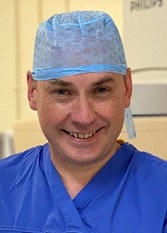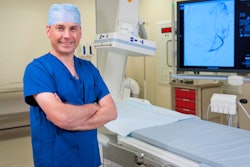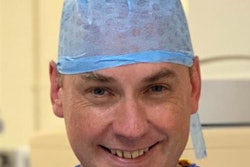
The process of designing the first Apple Macintosh computer in the early 1980s was an arduous one. The exacting demands of Apple Co-Founder Steve Jobs resulted in his employees and colleagues describing a "reality distortion field" around him and the people who came into his orbit, within which the impossible became possible.
Rectangles with rounded corners when the processor couldn't draw a circle? No problem. A device with a footprint smaller than a phone book when everything else was three times this size? OK. Shave half a minute off an already streamlined boot process? Yeah, we can do that.
Jobs was able to bridge the gulf between expectation and reality through the clarity of his idea, assisted by the sheer force of his personality, his drive, his obsession, and a large dose of behavior one might describe as bullying.
The gulf between expectation and reality
 Dr. Chris Hammond.
Dr. Chris Hammond.In today's U.K. National Health Service (NHS), we see a huge gulf between expectation and reality. Amongst other laudable aspirations, NHS England (NHSE) expects to eliminate elective waits of over 65 weeks by March 2024, diagnostic activity should be 120% of pre-pandemic levels by April 2023, there will be improved cancer waiting times and outcomes and delivery of 50 million more general practitioner appointments, maternity services will be improved, and a balanced budget will be delivered.
And yet as I write, emergency departments are full to overflowing, and secondary care is snarled up, as social care cannot take discharges. High-cost resources like operating rooms stand idle as hospitals grind to a halt. Primary care is drowning in demand. Much infrastructure is aging. Estates are frequently tired, cramped, and unfit for purpose. In this context, a reality distortion field with the metaphorical power of a black hole is required to make NHSE's objectives seem even remotely achievable.
And yet there are things that can be done: Waste can be reduced and unnecessary bureaucracy eliminated, the skill mix can be improved and workforce better deployed, estates can be upgraded flexibly to allow for new ways of working, and services can be made more responsive to the needs of the people the NHS serves.
Perhaps demand or public and political expectations can be managed. Maybe artificial intelligence or other technocratic solutions can finally deliver on their promise. We can refresh our NHS and make it comparable again with the best of our neighboring nations.
The key role of staff
To achieve all this requires money. This is necessary but insufficient. It also requires people.
Without a motivated, engaged, enthusiastic, driven workforce, recovering from the current crisis will be impossible. It's the staff of the NHS and social care sector who identify the blockages and inefficiencies and create the solutions needed to improve at all levels: from the district nursing team to quaternary hospital service, from the clinic to the integrated care board.
This is not a new concept: the Kaizen methodology, with continuous improvement driven by all staff, is well established in business and healthcare. It is the staff who deliver.
Steve Jobs recognized the importance of people in delivering his vision. He surrounded himself with people he described as his A team. They achieved what they did because while he was a martinet character who was difficult to work with and prone to bouts of anger, rudeness, and extreme condescension, he was also inspiring and imbued loyalty and belief. People wanted to work for him, to deliver for him.
Given the strong vocational ethos in the NHS workforce, it should be easy to motivate its staff. But instead, I perceive disillusionment and learned helplessness such as I have never known before. This is corrosive to initiative and problem-solving.
Motivating the workforce means paying people appropriately and recognizing that pay and compensation have a salient effect on the recruitment of new colleagues and retention of old ones as well as morale. It means publishing a long overdue workforce strategy. It means listening and understanding the daily frustrations that erode professionalism and vocational drive. It means appreciating that working in aging buildings with aging equipment will inevitably breed apathy. It means transformative investment.
Urgent need for vision
In addition to this investment, the NHS also needs a transformative vision, akin to that seen at its inception. This means having the bravery and honesty to start a public discourse on how to fund the NHS and social care long term: what we can (or choose to) afford as a country and what we can (or will) not. It means addressing difficult policy decisions about cost-effectiveness and service rationing with the public, professionals, and industry. It means addressing both the demand for -- and supply of -- healthcare.
Everyone I know in the NHS recognizes the fact that we cannot go on as we are, spending more and more on increasingly marginal outcomes.
And this is where the reality distortion field can help: With the development of a transformative vision and a clear commitment to transformative investment, I believe the NHS's staff will deliver the solutions required. It has happened before and can happen again. Even before the money flows, the idea that the government understands and is committed to action will empower the workforce. It will allow the distortion field to develop and the gulf between expectation and reality to be bridged.
Until the vision is developed and the investment begins, there will be no reality distortion in the NHS. Just grim reality.
Where might the vision come from? It's clearly not from our current government, which seems to only have a wish list of near-future outcomes expedient to help with their prospects at the next general election.
To me, the only option seems to be a long-term collaborative effort across successive parliaments and political ideologies and involving all public, private, patient, and professional stakeholders to co-create it.
Whether there is the political will, executive structure, or inspiring leader to facilitate this remains to be seen. U.K. Secretary of State for Health and Social Care Steve Barclay is not Steve Jobs.
Dr. Chris Hammond is a consultant vascular radiologist and clinical director for radiology at Leeds Teaching Hospitals NHS Trust, Leeds, U.K.
The comments and observations expressed herein do not necessarily reflect the opinions of AuntMinnieEurope.com, nor should they be construed as an endorsement or admonishment of any particular vendor, analyst, industry consultant, or consulting group.




















